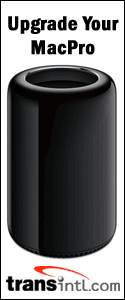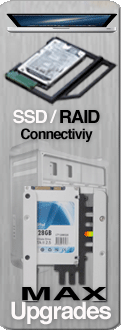SHOOTOUT:
iMac Intel Core Duo 2.0GHz
versus Others
Originally posted January 20th, 2006, by rob-ART
morgan, mad scientist
Updated February 3rd, 2006, with Radeon X800 XT results for some tests.
Updated February 9th, 2006, with "twice as fast" discovery.
We now have a iMac Intel Core Duo 2.0GHz in the lab so we're able to give you a more complete picture of what it can do. The biggest insight has to do with the performance gain from Universal versions of Mac software.
UNIVERSAL BINARIES (UB)
All graphs in this first section show the iMac Intel Core Duo running software with Universal Binaries (UB) -- modified to run in native mode on both PowerPC (G5) and Intel (Core Duo) processors.
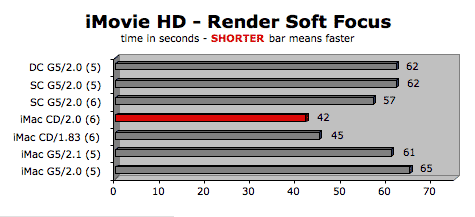
The number 5 or 6 next to each line indicates what version of iMovie HD was running. iMovie HD 6 may have some new efficiencies but that doesn't explain why the iMac Core Duo beat all comparable Macs so badly.
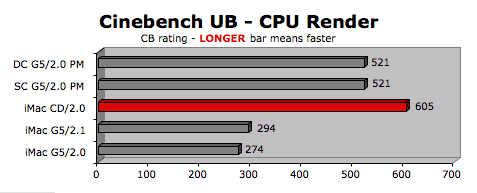
In above graph, we used Cinebench 9.5, which is the Universal Binary version.
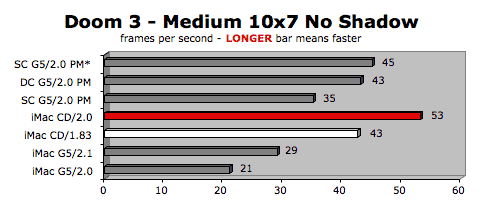
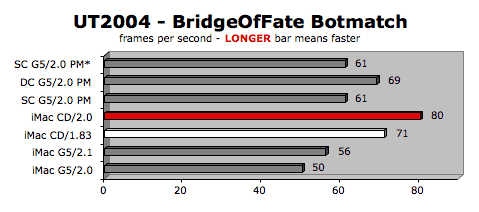
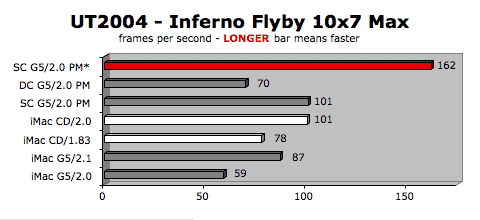
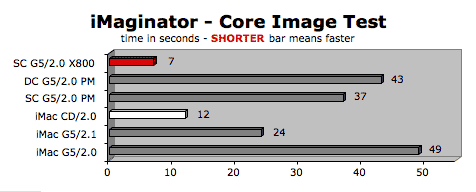
NON - UNIVERSAL
The graphs below contain results from software that runs on the iMac Intel Core Duo (with the help of Rosetta), but has not been modified to run natively on the Intel processor. They have NON-Universal binaries. As you can see, the iMac Intel Core Duo is at a disadvantage when running software in that mode.
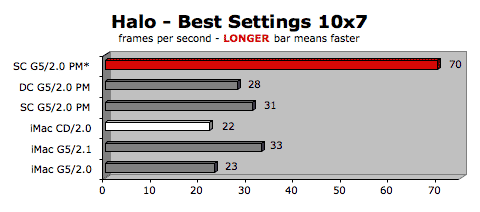
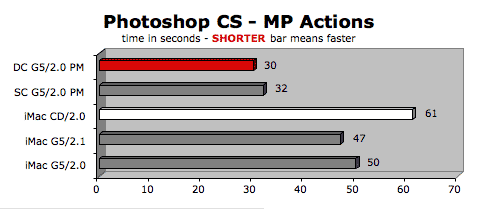
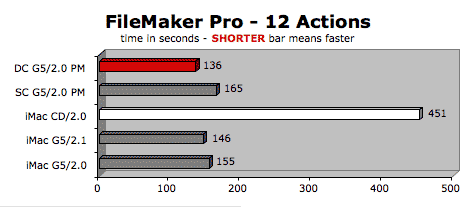
Graph Legend:
iMac G5/2.0 = May 2005 iMac G5/2.0GHz 'ALS' 20" with Radeon 9600
iMac G5/2.1 = Oct 2005 iMac G5/2.1GHz 'iSight' 20" with Radeon X600XT
iMac CD/1.83= Jan 2006 iMac 1.83GHz Intel Core Duo 17" with Radeon X1600
iMac CD/2.0 = Jan 2006 iMac 2.0GHz Intel Core Duo 20" with Radeon X1600
SC G5/2.0 PM= Oct 2004 Single-Core Dual G5/2.0GHz with Radeon 9600 XT
DC G5/2.0 PM = Oct 2005 Dual-Core G5/2.0GHz with GeForce 6600LE
SC G5/2.0 PM* = Oct 2004 Single-Core Dual G5/2.0GHz with Radeon X800 XT
FINAL ANALYSIS
As long as we used Universal Binary (UB) versions of software (iMovie HD 6, iDVD 6, Cinbench, UT2004, Doom 3, etc.), the iMac Intel Core Duo was impressive. In this initial round of testing, the Core Duo wasn't "twice as fast" as the previous model (as Apple claimed). However, as of February 9th, we reran the Doom 3 test at High Quality with Dynamic Shadowing enabled (1024x768). This time the Core Duo was 129% faster than the iMac G5/2.1 -- or 2.3 times faster -- just as Apple displayed on their iMac Graphics page. And for the record, we only had 128MB of VRAM on the Core Duo we borrowed.
As for non-UB software (Photoshop, FileMaker Pro, Halo) the performance was mediocre compared to previous iMacs and "low-end" Power Macs. Some non-UB software will not run or runs crazy.
Before you buy an iMac Core Duo or recommend it to your friends, better check whether key software is Universal Binary (UB) first. MacInTouch has a list of all the software that is UB or promised to become UB. Apple has a listing by category.
FLASH: World of Warcraft UB Results
We admit we are novices at benchmarking with with WoW, but our first round of testing produced some interesting results.
|
|
Windowed Mode
|
Full Screen
1680x1050*
|
|
Core Duo 2.0
|
37 fps
|
18 fps
|
|
Single-Core G5/2.5
GeForce 6800 Ultra
|
33 fps
|
35 fps
|
|
Quad-Core G5/2.5
Quadro FX 4500
|
41 fps
|
40 fps
|
* Since the G5 towers were using a 23" Cinema, we couldn't run at the Core Duo's native 1680x1050 -- nor would WoW let us use custom rez.
So we made the G5s run at 1920x1200 instead.
Here's our point: If you typically play WoW in Windowed mode with high quality settings, you'll be thrilled. But if you prefer to play in full screen mode at native resolution, you won't. You'll need to drop the Core Duo down to lower resolution and lower quality settings. FYI: In our test, all settings were at max or enabled except Full Screen Glow Shading (off) and Vertical Sync (off). We captured the frame rates by entering the Hellscream realm and standing on the little bridge that faces the Elwynn Forest (Southeast).
iDVD CONSPIRACY?
We confirmed that iDVD 6 encodes slower than iDVD 5. Some readers suggested that Apple "hobbled" iDVD 6 to make the Intel based iMac look stronger against PowerPC based Macs, but our testing does not support that assertion.
iDVD 5 + Dual G5/2.0GHz Power Mac = 5 min 16 sec
iDVD 6 + Dual G5/2.0GHz Power Mac = 6 min 50 sec
iDVD 6 + iMac Intel Core Duo 2.0GHz = 7 min 57 sec
USB 2.0 is FASTER on the iMac Intel Core Duo than on the Quad-Core G5 Power Mac! One of our readers was pondering whether the speed of USB 2.0 might be improved on the Intel based Mac. So we ran some QuickBench tests using a Maxtor DiamondMax 10 and Wiebetech SuperDriveDock+ (USB2 + FW800). Here's what we observed:
Quad-Core built-in USB2 = 11MB/s READ, 11MB/s WRITE
Quad-Core with Aaxeon USB2 card = 15MB/s READ, 11MB/s WRITE
iMac Intel Core Duo 2.0 built-in USB2 = 18MB/s READ, 14MB/s WRITE
(of course, FireWire is faster)
iMac Intel Core Duo 2.0 built-in FW400 = 39MB/s READ, 28MB/s WRITE
Quad-Core built-in FW800 = 58MB/s READ, 50MB/s WRITE
IMPRESSIVE GPU
We're pleased with Apple's decision to use the X1600 graphics processor with 12 pixel pipelines in the iMac Core Duo. The only Mac graphics processors with more pixel pipes are the high-end Power Mac cards (X800 XT, 6800 GT/Ultra, 7800 GT, and FX 4500).
You might wonder why we compared the Core Duo to systems with GPUs that had no more than 4 pixel pipes. For starters, we had no choice when it comes to previous iMac systems. As for the Power Macs, we chose the standard GPU with which they ship or shipped.
It's also important to note that we used 1024x768 when running the 3D games. It is a resolution that should not "push" the graphics processors. To help prove our point, we added results for a G5/2.0GHz Power Mac with a Radeon X800 XT (16 pipelines) -- the closest thing in our lab to the iMac's Radeon X1600.
In the case of Doom 3, we only specified "Medium" and turned off Dynamic Shadows. The X800 XT didn't help the G5 Power Mac catch up to the iMac Core Duo.
UT2004 tends to be CPU bound at 1024x768 especially when running botmatches -- which simulate actual game play. Notice that we got the same framerate from the G5 with the X800 as we did with the 9600 XT. On the other hand, when we ran the UT2004 Flyby -- a pure graphics function, the X800 produced much faster frame rates. It also screams when we run iMaginator, our Core Image tester.
But the real point is that we really are impressed with the graphics power you get with the iMac Core Duo which sells for half the price of a comparably equipped G5 tower running at the same clock speed. (See chart below.)
MISCELLANEOUS NOTES
1. The Core Duo may give the iMac dual processors, but in a sense, it is a step down. The cores are low power 32 bit processors ideal for laptops, as seen by the MacBook Pro's used of the same processors. One "effect" of not being 64 bit is that it can't address more than 4GB of memory, though this shouldn't be a problem for iMacs and MacBooks. (The G5 in the previous model of iMac was a 64 bit prodessor.) Hopefully we'll see 64 bit versions of Intel processors in the near future --- at least in the upcoming Intel based "MacTower Pro."
2. The 2MB L2 cache is shared by the two cores whereas the Dual-Core G5s have separate L2 cache. That's not necessarily a bad thing, especially if inter-process-communication is going on in multithreaded code (one CPU needs data from another CPUs Cache) but there is a slight penalty (in nano seconds) when each processor waits for the other to finish accessing the cache.
3. The FireWire 400 port does not produce enough bus power to run our 3.5" bus powered FireWire drives (Wiebetech UltraGB+) but it does mount our 2.5" FireWire drives. It's a scandle that the iMac Core Duo doesn't have FireWire 800 -- or better yet -- an external SATA port. Ditto for the MacBook Pro.
4. Good news. You have two user serviceable memory slots instead of one as in the previous model of iMac. That makes it affordable to attain the maximum advertised 2GB of capacity. The memory modules are SODIMMs which are usually found in laptops. We accidentally installed 533Mhz modules instead of 667MHz modules specified. To our surprise, we got the same results when we reran our tests with 667Mhz modules. Hmm.
We still can't understand why Apple charges $300 for a 1GB module that can be bought for around $100 everywhere else.
5. If you are trying to choose between an iMac Core Duo and a G5 Dual-Core Power Mac, keep in mind that the iMac Core Duo not only costs HALF as much comparably equipped, but it is much quieter. For some of you, quiet is more important than expandability. But if sound is not the issue, here's what you have to consider when choosing between two:
|
iMac Intel
Core Duo 2.0GHz
|
Dual-Core G5/2.0GHz
Power Mac
|
| Memory slots |
2
|
8
|
| Drive bays |
1
|
2
|
| Frontside bus |
667MHz
|
1000MHz
|
| PCI Express slots |
0
|
4
|
| GPU upgradeable |
no
|
yes
|
| iSight built-in |
yes
|
no
|
| Remote |
yes
|
no
|
| FireWire |
400
|
400/800
|
| Price with 20" LCD |
$1699
|
$3273**
|
** Comparably equipped -- including 250GB hard drive, GeForce 7800 GT, and 20" Cinema display. We went shopping on eBay for a used Single-Core Dual G5/2.0 Power Mac with used 20" Cinema and used Radeon X800 card. The total came to about the same price as a new iMac Core Duo 2.0.
RELATED ARTICLES
MacWelt has posted their Core Duo results.
SantaDuck is busy comparing various Macs using the Universal UT2004.
iMac Core Duo disassembly instructions
Anandtech compared the Core Duo processor used in the new iMac with other Intel and AMD processors.
WHERE TO ORDER YOUR IMAC CORE DUO
When ordering products from Apple Store USA, please click THIS TEXT LINK or any Apple display ad as your "portal" to the online store. In so doing, you help to support Bare Feats.
WHERE TO BUY REFURBISHED or CLOSEOUT iMACS (12 month warranty)
For refurbished, reconditioned, open box (as well as new) iMacs, check with Small Dog and Power Max. Also look for the "SPECIAL DEALS" link on Apple's online store.
Many thanks to CryWolf, our local Apple dealer, who provided some of the systems we used for testing. Check out their silencer cabinets for Power Macs and Xserves.
Has Bare Feats helped you? How about helping Bare Feats?
© 2006 Rob Art Morgan
"BARE facts on Macintosh speed FEATS"
Email
, the webmaster and mad scientist
|



